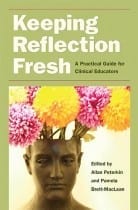JTH Connor
St. John’s, Newfoundland
 |
Allan Peterkin is a professor of psychiatry and family medicine at the University of Toronto, Canada. As a teacher and author he is probably best known for his survival guide to post graduate medical studies, Staying Human During Residency Training: How to Survive and Thrive after Medical School, which is now in its sixth edition. Peterkin is now adding to his body of literary work with the two books reviewed here as a champion of the medical humanities and founding editor of Ars Medica: A Journal of Medicine, the Arts, and Humanities.
Portfolio to Go is designed for student use, but it not a textbook per se. Rather, it is formulated more like a workbook because its purpose is to prompt and provoke clinical learners to write reflectively. As Peterkin explains, many undergraduate medical programs in North America now incorporate medical humanities modules that require a cumulative record of students’ reactions and responses—their reflections as recorded in writing portfolios—to events, incidents, and impromptu occasions that constitute the daily life of a medical learner. The overall process goal is build “reflective capacity” in order to “help develop critical thinking skills, inform clinical reasoning, and enhance professionalism.” This process is one of meta-cognition where “experiences are transformed into meaning making . . . new insights, knowledge, and practices” (p. 6). The book’s chapters contain over 1000 writing prompts on topics such as communication, collaboration, conflict, personal narrative, diversity, social justice, well-being, ambiguity, the hidden curriculum, and professionalism and ethics. Other chapters deal with creativity, graphic medicine, social media, and outlets for formal publication.
Complementing Portfolio to Go is Keeping Reflection Fresh, aimed at educators rather than at students. In this work Peterkin and his co-editor, who teaches arts and humanities at the University of Alberta, proffer over 100 brief essays on the constructive role of reflection in medical education. The essayists from the United States, Canada, Switzerland, Israel, Australia, New Zealand, Hong Kong, and the United Kingdom present a truly international perspective. The authors are doctors, nurses, educators, theologians, medical students, art and music therapists, actors, poets, psychologists, humanities scholars, mental health counselors, and artists, which results in a cornucopia of ideas, perspectives, and approaches to the topic of keeping reflection fresh. The editors have organized the book into sections that include narrative approaches; visual reflection; performance and reflection; learning from patients and clients; ethics and professionalism; spirituality and mindfulness; curriculum design and innovation; and new media. Notes at the end of each essay point readers to key sources, and a detailed index further helps to navigate the essays and cross-reference topics.
Portfolio to Go and Keeping Reflection Fresh are both pointedly operational in their approach to humanities in medicine: the purpose of both books is to harness the arts in the service of medicine. By using the content of film, literature, and fine art, for example, along with embracing how such fields are taught by academic scholars (writing, discussion, and reflection), the endgame is to produce better healthcare practitioners and improve patient care. Humanities scholars who are actively engaged with undergraduate medical education will understand the merit of this approach, but purists might decry the “demeaning” of humanities in this way because of its utilitarianism. However, if the most egregious of clinical encounters, perhaps imbued with paternalism, poor communication, or overly reactive behaviour can be tempered or eliminated by a humanities module that develops reflective capacity, then this approach has value.
Readers of Portfolio to Go and Keeping Reflection Fresh will do well to supplement these works with others by leaders such as Rita Charon and Kathryn Montgomery Hunter. The two books reviewed here, with their creative approach to medical education, may help to generate a convincing course proposal of merit for even the most hard-headed medical curriculum committee.
For more
Reviews of Allan D. Peterkin, Portfolio to Go: 1000+ Reflective Writing Prompts and Provocations for Clinical Learners (Toronto: University of Toronto Press, 2016) ISBN 9781487520113, x+178 pp. CDN$ 29.95, paper; and Allan Peterkin and Pamela Brett-MacLean, eds., Keeping Reflection Fresh: A Practical Guide for Clinical Educators (Kent, OH: Kent State University Press, 2016) ISBN 9781606352830, xxix+404pp, US$ 45.00, paper.
JTH CONNOR is the John Clinch Professor of Medical Humanities and History of Medicine, Faculty of Medicine, Memorial University of Newfoundland, St. John’s, Canada; he also holds an appointment in the Department of History. Previously, he was Assistant Director (Research and Collections) at the National Museum of Health and Medicine (formerly the Army Medical Museum), Washington, DC. He has published widely on science, technology, and medicine in North America, as well as aspects of medical museums.
Spring 2017 | Sections | Books & Reviews

Leave a Reply